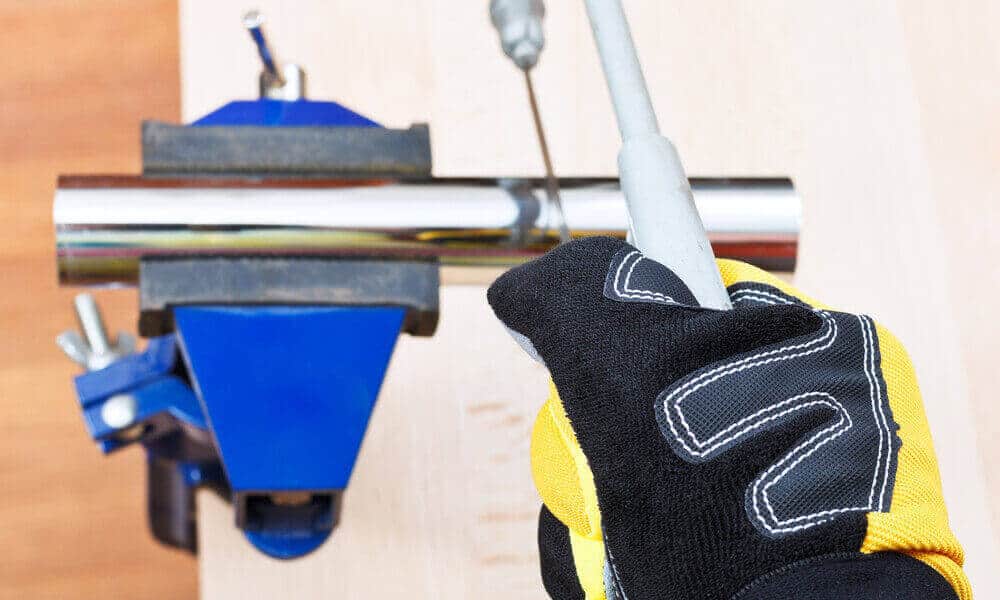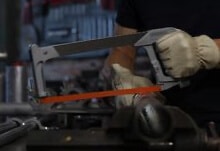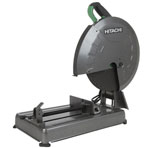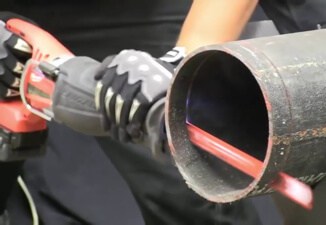January 6, 2021

Imagine yourself cutting through a piece of metal, and you’re already sweating profusely. Yet, you are not making significant progress in your cut. Well, you might be using the wrong saw, or your saw does not have a suitable blade for cutting such material.
When cutting hard metal, you can either use a hand saw or a power saw. It will help if you meticulously choose the blade type you will use depending on the metal composition. It will also be useful to consider the metal’s size and the characteristics of the cuts you would like to produce.
Hand Saws You Can Use for Cutting Metal
So, if you intend to cut metallic materials, you need to learn which saw to use and be cognizant of their capabilities. It will help to learn about various metals’ properties to zero in on the right blade and saw. Here is a shortlist of the saws you can use for cutting metals:
1) Hack Saw

The most common saw that you could use for cutting metal is the hack saw. It is characterized by rigidity and a C-shaped frame with a pistol grip handle. The open portion of the C-shaped frame runs the flexible blade. The blades are available in various spacing according to the application.
So, if your blade comes with small and closely spaced teeth, you can use it to get an excellent fine cut. This type of blade teeth is for cutting thin metallic materials like aluminum and cutter.
On the other hand, you can use a hacksaw with a blade that comes with large and widely spaced teeth for creating coarse cuts. These types of blade teeth are for cutting hard and thick metal materials like steel and iron. You will find a hack saw in most workshops because of its versatility of use. You just need to move the blade of the hack saw through the metal, either using a backward or forward motion.
Hack saws are also affordable as compared to powered saws. Moreover, you can select from a variety of blades at hand. You can also select from a wide varieties of handles. You can buy handles that provide 150kg or 30,000 psi blade tension.
Besides, you can adjust the handle to accommodate either 250 or 300mm blades. Moreover, you can adjust the blade’s angle or set it up to a secondary position to enable you to engage in flush cutting or general cutting.
You can select hack saw blades according to the correct TPI (teeth per inch). The blades with higher TPI, of course, are the more aggressive in cutting.
You can easily set up or mount the blade with its teeth facing backward or forwards. You can start cutting using away stroke or towards stroke. Of course, the primary cutting stroke is the away stroke, for this provides a clear line-of-sight on the cut because the chipped metals move forward when you use this stroke.
2) Metal Chop Saw

The metal chop saw is like the miter saw of woodworkers. Its blade lowers through the metal that rests on a stationary platform. This type of saw is heavy-duty and is best for withstanding heat, flying metal, and sparks that the cutting process creates.
The metal chop saw is easy to use. You need to position the metal material on its base underneath the blade. Then, activate the blade and lowers it on the material.
Many newbies think that they can use the metal chop’s blade saw on the miter saw. Well, their reason is that the miter saw and the metal chop saw are the same in appearance. Yet, I would not suggest doing that.
3) Reciprocating Saw

Another saw that you could use to cut metal is the reciprocating saw. It makes use of a long metallic cutting blade that creates back and forth motions. Its cutting motion is like that of the hacksaw. This saw is usually light and easy to use. You can also use it to work on any tight spaces or hard-to-reach space.
The reciprocal saw is perfect for cutting through any metallic materials. It is flexible, but its cutting motion may produce uneven cuts or results. For this reason, the reciprocating saw is not the primary saw preferred for cutting fine metal materials. Nevertheless, you will often find this saw used in most demolition jobs.
You have two choices when setting up the reciprocating saw. You can either set it up oscillating or straight. You can extend its blade’s life by using slow and steady speed when cutting. It will help if you choose a 20 to 24 TPI blade when cutting thin metal.
However, you should use 10 to 18 TPI blades when cutting through medium-thickness metal. The 8 TPI blades are perfect for cutting through thick metal. Lastly, you should select carbide-tooth or bi-metal blades if you want a longer-lasting blade.
Conclusion
There are other types of saws that you can use for cutting metals, like the handheld circular saw that can create straight cuts through most types of metals. You can also use a grinder for cutting metals, which comes with a spinning abrasive disc for cutting through metal.
Moreover, you can use a band saw whose blade is supported by two good rollers. It can cut through metal with its quick-moving horizontal motion. Its blade is like that of the hacksaw, and it is easier to handle than the reciprocating saw. It can also create burr-free cuts as compared to that of reciprocating saw.
